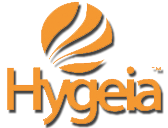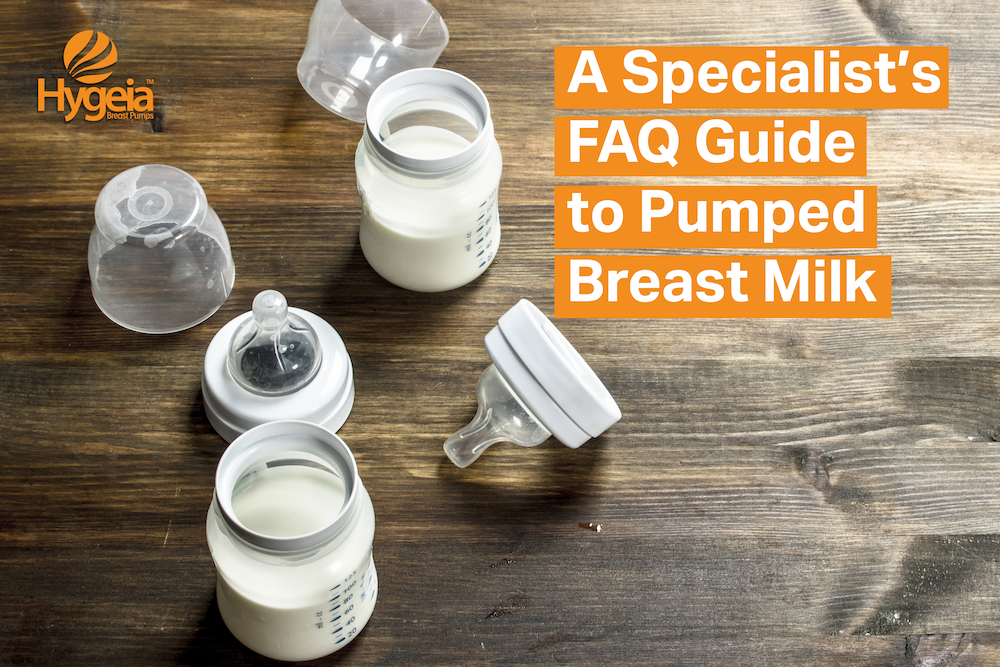
Your pumped breast milk is often called ‘liquid gold,’ and that label is spot-on—it’s a powerful, living source of nutrition and protection for your baby. Dedicating yourself to pumping, is just the first step of the process a. Knowing exactly how to handle and store your expressed breast milk is what gives you peace of mind.
Your milk is packed with live antibodies and nutrients, and proper storage is essential to preserving its integrity. This guide cuts through the confusion, offering you the straightforward, reliable rules you need. We specialize in high-quality breast pumps like the Hygeia Express because effective milk expression is the foundation of safe storage. Let’s dive into the essential facts about your baby’s liquid gold.
The Essential Rules of Breast Milk Storage
Safe storage is non-negotiable. The preferred storage method for freshly expressed milk is simply a refrigerator and having there for no more than 4 days. However, life is wild and many situations won’t present handy refrigerator storage. Additionally, you may want to to have a back-up supply of milk and the freezer will be necessary. Follow these simple guidelines—often called the “Rule of 4s” to help you remember 4 hours on the counter or 4 days in the fridge. Always remember to store milk in clean containers labeled clearly with the date and amount.
- Countertop: Up to 4 Hours
- Insulated Cooler: Up to 24 Hours
- Refrigerator: Up to 4 Days
- Freezer: Up to 6 Months
- Deep Freezer: Up to 12 Months
Simple Storage Tips:
Beyond the time guidelines for storage, safety depends on precise handling. Here are a few essential tips for ensuring the quality of every ounce you store.
-
Combine Safely: Only combine milk from different sessions if the newer milk has first been cooled to the same temperature as the older, chilled milk. Never mix warm milk with cold or frozen milk.
-
Small Portions: Store milk in 2 to 4-ounce portions. This prevents waste and allows for quicker cooling and thawing, which helps preserve those vital nutrients.
-
Thawing Wisdom: Thaw frozen milk in the refrigerator overnight. For faster thawing, use a bowl of warm water.
- Never use a microwave to thaw or warm milk, as this destroys antibodies and creates dangerous hot spots.
-
Never Refreeze: Thawed breast milk must be used within 24 hours (if thawed in the refrigerator) and must never be frozen again.
The FAQ of Stored Milk
Why does my stored milk look separated?
This is completely normal! Breast milk separates into layers when stored. The creamy, fatty layer (hindmilk) rises to the top, and the watery layer (foremilk) stays at the bottom. Gently swirl the container to remix the layers before feeding; do not shake it vigorously.
Why are the colors different?
The color can vary greatly based on your diet, hydration, and supplements. For instance, green milk can result from eating green vegetables or certain vitamins; yellow or orange milk is common if you have a high intake of beta-carotene. As long as the milk smells fresh, these color changes are usually safe. Learn more about your breast milk colors here.
Why does thawed milk smell soapy or metallic?
This is often due to high levels of lipase, an enzyme that breaks down fats. While the milk is still safe and nutritious, some babies may dislike the resulting taste. To prevent this, you can scald (heat quickly, then cool) fresh milk before freezing it to deactivate the lipase.
What does spoiled milk smell like?
Spoiled milk smells distinctly sour, rancid, or cheesy—like spoiled cow’s milk. If there is any noticeable bad odor after thawing, discard it immediately.
Keep your confidence with the right pump
We know the effort it takes to maintain your supply and ensure safe storage. That commitment is why we engineer high-quality hospital-grade breast pumps that deliver consistent, effective milk expression—a crucial factor in your success. Because most insurance plans cover the cost of a breast pump, we at Hygeia love helping moms figure out their coverage.
Let us support your confidence in providing the best for your baby. Apply today and Hygeia will assist in getting your high quality breast pump covered 100% by your insurance.

Maternity leave is often talked about as this peaceful stretch of time when you bond with your baby; you get to rest, and enjoy slow days at home. The truth, if you ask any experienced mother, is usually quite different.
For many mothers, maternity leave is a mix of recovery, learning curves, emotional highs and lows, and the nonstop needs of a newborn. The gap between expectation and reality can feel huge, and that gap is exactly what leaves many women feeling unprepared.
This article takes a clear look at common misconceptions about maternity leave. Instead we hope to give the reality of what the early weeks are like and how you can prepare in practical, confidence-building ways.
Misconception 1: “Maternity leave will feel like a break.”
Reality: Maternity leave is not a vacation. Your body is healing. Your hormones are shifting. Your sleep is interrupted every few hours. Most mothers spend their days feeding, pumping, soothing, and repeating the cycle. Even moments of rest are tied to your baby’s schedule.
How to prepare:
- Build a support plan for meals, household tasks, and childcare for older children before you deliver if possible.
- Do not turn down help even if you think you “should” be able to do it all yourself.
- Create a simple feeding plan. If you plan to breastfeed or pump, know what resources are available before your baby arrives.
Misconception 2: “I’ll have plenty of time to get things done.”
Reality: Newborns often nurse eight to twelve times per day. Feeding sessions can be long, and the hours between them pass quickly. Many mothers are surprised at how little time they have for anything beyond basic needs.
How to prepare:
- Lower your expectations for productivity. Your only goals should be to recover while nurturing and feeding your baby.
- Stock up on easy, one-handed snacks and bottles of water for breastfeeding or pumping sessions.
- Create small “stations” around the house: diapers in more than one room, burp cloths within reach, and a comfortable spot to nurse or pump.
Misconception 3: “Bonding will happen instantly.”
Reality: Many mothers expect love to rush in the moment their baby arrives. While this does happen for some, bonding can also develop slowly. You are recovering physically and learning a new baby who is still figuring out how to communicate with you.
How to prepare:
- Give yourself grace if bonding takes time and know it is common with many mothers.
- Practice skin-to-skin as much as you can; even if you are not breastfeeding, letting baby sleep skin to skin helps the bond.
- Talk with your partner or support person about emotional check-ins during the first few weeks.
Misconception 4: “Breastfeeding will come naturally.”
Reality: Breastfeeding is a learned skill for both mother and baby. Sore nipples, latch challenges, and round-the-clock feedings can make the beginning feel overwhelming. Many women assume they are “doing it wrong” when the truth is that the early weeks are an adjustment period.
How to prepare:
- Meet with a lactation consultant before birth or schedule an appointment for the first week home. You can also have one visit you while you are in the hospital.
- Learn the basics of latch, feeding cues, and normal newborn behavior.
- If you plan to pump, choose a hospital-grade breast pump so you can establish and maintain supply more comfortably during this demanding season.
Misconception 5: “I’ll feel like myself again in a few weeks.”
Reality: Physical recovery can take several months. Emotional recovery can take even longer. You may feel tired, overwhelmed, or sensitive in ways you didn’t expect. None of this means you are doing anything wrong.
How to prepare:
- Have open conversations with your partner about mental health, sleep, and postpartum expectations.
- Know the signs of postpartum anxiety and depression before you need the information.
- Plan for small, practical forms of self-care, like short walks or a shower without rushing. Set these goals with your partner or a support person.
Misconception 6: “I’ll slide easily back into my old routine when maternity leave ends.”
Reality: Whether you are returning to work or continuing to stay home, your life has changed in meaningful ways. New routines take time to build. Returning to work often comes with a mix of pride, guilt, relief, and sadness. All of this is normal.
How to prepare:
- Talk with your employer early about pumping breaks, flexible schedules, and transition needs.
- Practice your pumping routine at home so it feels familiar once you return to work.
- Build a transition week into your plan. A few half-days can help you and your baby adjust gradually.
Turning Expectations Into a Realistic and Supportive Plan
Maternity leave is not a single experience. It is a major life shift filled with learning, adjusting, healing, and caring for a brand-new person. When you understand the realities instead of the picture-perfect expectations, you can prepare with more confidence and compassion for yourself.
At Hygeia Health, our focus is supporting mothers through every phase of feeding, pumping, and postpartum recovery. The right tools, along with clear information and thoughtful planning, allow mothers to navigate maternity leave with more ease.
Comfort and confidence in breastfeeding are a huge part of a positive maternity leave. Our hospital-grade breast pumps support this aspect. Apply today and Hygeia will assist in getting your high quality breast pump covered 100% by your insurance.
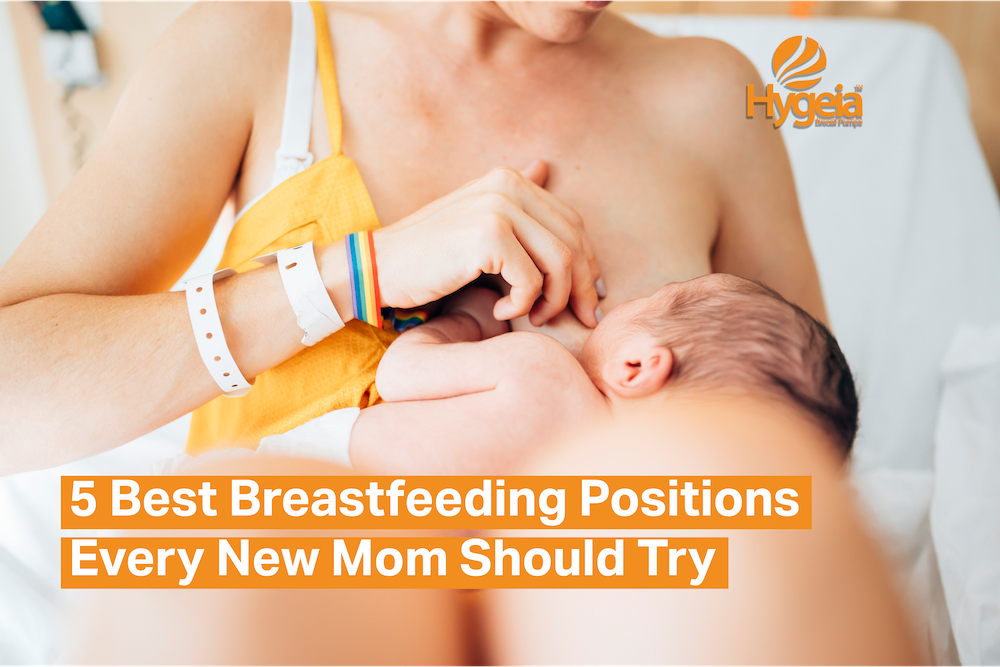
Finding the breastfeeding position can make all the difference in your comfort and your baby’s feeding success. Every mother and baby pair is unique, so what feels natural to one person might not work for another. The key is to experiment, stay relaxed, and choose positions that help your baby latch deeply while keeping you both comfortable.
Below are some of the best breastfeeding positions to try—each one with its own advantages depending on your body, your baby’s age, and your feeding goals. As you try different holds, it doesn’t hurt to ask for help from someone with experience to be sure you are getting them right. A nursing pillow can give you more freedom to get yourself and baby comfortable as these positions become more natural to you both.
1. The Cradle Hold
The cradle hold is one of the most classic breastfeeding positions and often the one new mothers try first.
How to do it:
- Sit upright in a comfortable chair or on a supportive bed.
- Hold your baby so their head rests in the bend of your arm, with their body turned toward you.
- Make sure your baby’s nose is level with your nipple and their head, neck, and body are aligned in a straight line.
Why it works: This position promotes closeness and eye contact. It’s ideal once your baby has developed a stronger neck and feeding rhythm. For newborns, it may take a little more coordination, so don’t be discouraged if it’s tricky at first.
Tip: Support your arm with a nursing pillow or rolled-up blanket to reduce shoulder and wrist strain.
2. The Cross-Cradle Hold
The cross-cradle hold is similar to the cradle hold but gives you more control over your baby’s head and latch—making it perfect for newborns or babies who need a little help getting a deep latch.
How to do it:
-
Sit upright and hold your baby across your body, tummy to tummy.
-
Support their neck and shoulders with the hand opposite to the breast you’re feeding from (for example, use your right hand for your baby’s head when nursing on the left breast).
-
Use your free hand to guide your breast and help your baby latch.
Why it works: This position lets you guide your baby’s mouth precisely to the nipple and adjust as needed for a better latch. It’s especially useful during the early weeks when you’re both still learning.
3. The Football Hold (Clutch Hold)
If you’ve had a cesarean birth or have larger breasts, this position can be a game-changer.
How to do it:
-
Tuck your baby under your arm like a football, with their legs pointing toward your back.
-
Support their head and shoulders with your hand and use a pillow under your arm for comfort.
-
Bring your baby’s mouth to your nipple, keeping their nose clear for easy breathing.
Why it works: It keeps pressure off your abdomen, supports smaller or premature babies, and helps you see your baby’s latch clearly. Many moms find it easier to maintain a deep latch in this position.
4. The Side-Lying Position
This one’s all about rest and relaxation—perfect for nighttime feedings or when you need to recover post-delivery.
How to do it:
-
Lie on your side with your baby facing you, tummy to tummy.
-
Support your head with a pillow and use another behind your baby’s back to keep them close.
-
Bring your baby’s nose to your nipple and allow them to latch naturally.
Why it works: You can rest your body while your baby feeds, and it’s gentle on your healing body after birth or a C-section.
5. The Laid-Back (Biological Nurturing) Position
This position takes advantage of gravity and your baby’s natural feeding instincts.
How to do it:
-
Recline comfortably on a couch or bed at about a 45-degree angle.
-
Place your baby tummy down on your chest, with their head near your breast.
-
Support your baby as they find the nipple and begin to nurse.
Why it works: This position encourages your baby to use their reflexes to find the breast and latch deeply. It also reduces nipple pain and helps milk flow naturally.
Comfort Tips for Every Position
No matter which position you choose, comfort for both you and your baby is essential. Here’s how to make feeding smoother:
-
Use pillows or cushions to support your arms, baby, and back.
-
Bring your baby to your breast, not your breast to your baby. Hunching forward can lead to back and neck pain.
-
Check for a good latch. Your baby’s mouth should cover most of the areola, not just the nipple.
-
Switch sides each feeding or halfway through to keep milk production balanced.
-
Stay hydrated and relaxed. Deep breathing before and during feeds can help your milk let down more easily.
- Ask for help. A lactation consultant can help you get comfortable or adjust your latch and hold appropriately, but even an experienced breastfeeding mom can be of great assistance.
Final Thoughts
Breastfeeding takes patience, practice, and a bit of trial and error. The “best” position is the one that feels right for both of you—one that supports your baby’s latch and your body’s comfort.
If you’re experiencing pain, soreness, or latch difficulties, don’t hesitate to reach out to a lactation consultant or your healthcare provider. Sometimes small adjustments make a big difference.
At Hygeia Health, we believe that comfortable, confident breastfeeding starts with the right support—both in guidance and in tools like our hospital-grade breast pumps. With knowledge, patience, and the right equipment, you can make breastfeeding a more enjoyable and successful experience for both you and your baby. Apply today to let Hygeia assist in getting your high quality breast pump covered 100% by your insurance.
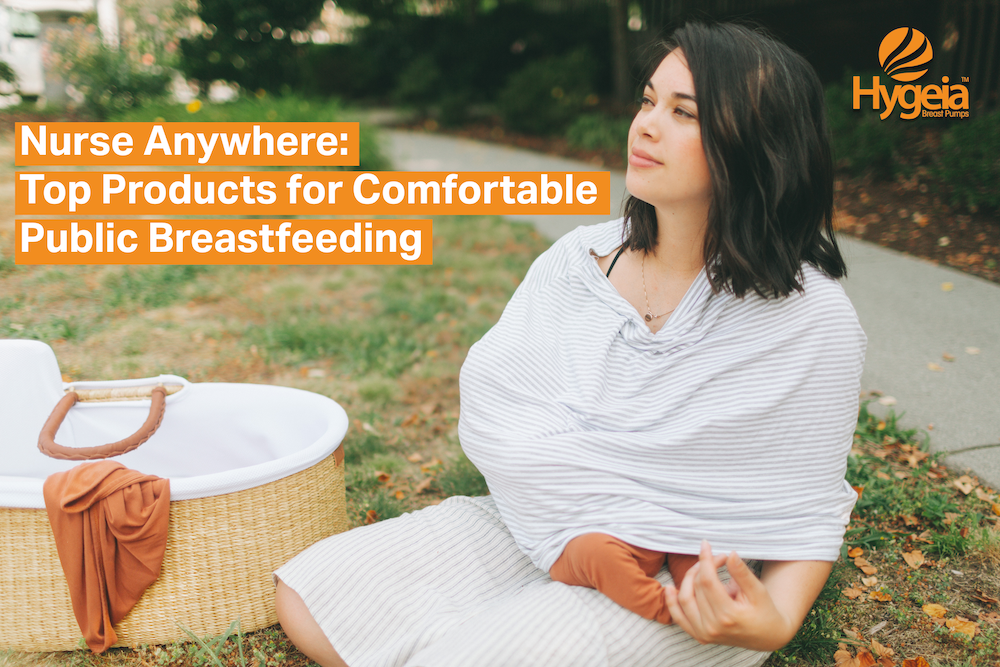
Breastfeeding in public is a powerful and natural act–let’s get that fact out in the open from the start. It allows you to nourish your baby whenever and wherever they need it. Because of this, no mom should ever feel that other people’s comfort should trump their baby’s need to eat. However, it’s also important to not judge each other as breastfeeding mothers. While you may not think twice about breastfeeding in a crowded restaurant, a first-time mom who is the first of her friends or family to breastfeed may not share your confidence
That confidence often comes with practice and early in the journey having the right tools can make a big difference. This blog covers the products meant to help create comfort, discretion, and convenience, empowering any mom to breastfeed anywhere.
Essential Apparel for Public Nursing
Choosing the right clothing can simplify public breastfeeding immensely.
Nursing Bras: A good nursing bra offers easy, one-handed access. Look for options with simple clasps or pull-aside designs. They provide necessary support while making feeding quick and discreet. Many brands offer comfortable, wire-free styles perfect for everyday wear.
What to choose? Check out this list of best nursing bras in 2025 from BabyList.
Nursing Tops: These tops feature hidden openings, lift-up panels, or crossover designs. They allow you to nurse without exposing your midsection or needing to lift your entire shirt. Pairing a nursing top with a cardigan or jacket can add another layer of discretion.
What to choose? Here’s a list of 30 of the best nursing tops in 2025 from MomLovesBest.
Layered Clothing: This simple strategy is often the most effective. Wear a loose top over a tank top. When it’s time to feed, lift the outer shirt and pull down the tank top. This creates a natural cover around your midsection while keeping you comfortable.
What to choose? Try these nursing tanks recommended by Mom Junction.
Covers and Privacy Tools
While not every mom chooses to use one, nursing covers can offer extra privacy. Some baby’s even come to prefer the cover!
Traditional Nursing Covers: These are often apron-style or poncho-style fabrics that drape over you and your baby. They come in various patterns and materials. Some have a rigid neckline that allows you to maintain eye contact with your baby.
Check it out: The Kids N’ Such Nursing Cover with a built in burp cloth.
Multi-Use Covers: Many popular covers double as car seat covers, shopping cart covers, or even scarves. This versatility makes them a smart investment for busy moms. They are lightweight and easy to pack.
Check it out: These top picks are extremely versatile and well loved.
Light Blankets or Swaddles: A simple, lightweight blanket or muslin swaddle can serve as an impromptu nursing cover. They are breathable and typically something you already carry for your baby.
Check it out: The Aden+Anais Muslin Swaddle Blankets are a long-time favorite.
Beyond the Products: Confidence and Rights
Remember, you have the legal right to breastfeed in public in all 50 U.S. states. The best product for public breastfeeding is often your own confidence. The tools listed in this blog simply offer practical ways to feel more comfortable and empowered as you nourish your baby, no matter where you are.
Use this guide to be well versed in your state’s public breastfeeding laws and how your rights are protected.
Pumping in Public
You also have every right to pump in public. The Hygeia Express is dependable for quick, quiet pumping when you need to relieve engorgement or express any amount of milk. With it’s collection cups the Hygeia Express even functions as a hands-free pump. By fitting inside your bra, it allows for completely hands-free and discreet milk expression. Weighing less than a pound, it is ideal for multitasking or pumping on the go without drawing attention due to it’s whisper quiet technology.
At Hygeia Health, we champion every breastfeeding mom. We understand the importance of reliable tools that integrate into your active life. We believe access to a quality pump is a right, not a privilege. Did you know that many insurance plans cover the cost of a breast pump? Hygeia Health specializes in helping moms navigate this process to get a 100% insurance-covered breast pump.
Ready to enhance your breastfeeding confidence with a high-quality pump designed for your active life? Apply today to see if you qualify for a free Hygeia Health breast pump.
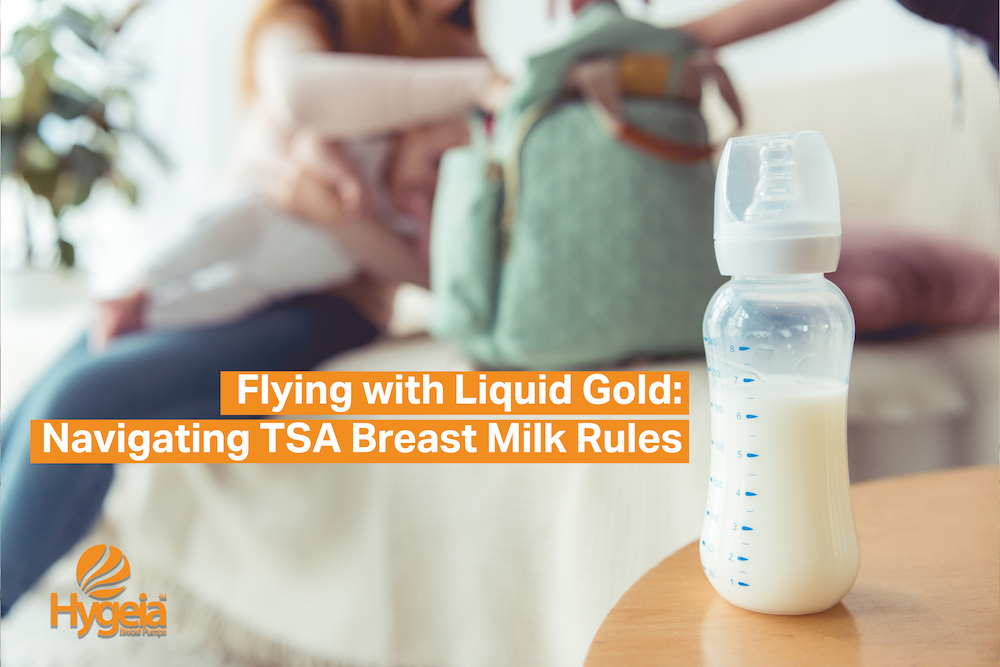
Vacation time has arrived! You’d be psyched if you weren’t stressing about what unexpected hiccups traveling with a baby may bring. One common concern is how to manage breast milk and breast pumps through airport security. The good news is, the Transportation Security Administration (TSA) has specific, clear rules designed to support parents. Understanding these TSA breast milk rules can help ease your travel worries and ensure your breastfeeding journey continues smoothly, even on the go.
TSA Breast Milk Rules: The Essentials
To give you some immediate relief, know that a mama’s breastmilk rules are different from the everyday passenger. When you’re flying with breast milk, it’s important to know the key regulations.
Exempt from the 3-1-1 Rule: Unlike other liquids, breast milk (and formula, and juice for infants) is exempt from the 3-1-1 rule for carry-on luggage. This means there is no quantity limit for how much milk you can bring. You heard that right: you can bring as much as you need.
The 3-1-1 Rule states a carry on bag is limited to 3.4oz (100mL) of liquid (3) in one (1) transparent quart size bag per passenger (1). But, reiterate, this does NOT apply to you, breastfeeding mama! You can carry breast milk in quantities greater than 3.4 ounces in your carry-on bag and it does not need to fit into a quart-sized bag.
Form of Milk: The rules–or lack of the 3-1-1 rule–applies whether your breast milk is fresh, frozen, or partially thawed. Just be prepared for them to be screened separately.
Note that it is possible that TSA will also require partially thawed breast milk for testing. It’s not common and just depends on the airport. They could require enough liquid to use a sanitary test strip to test it.
Cooling Aids Allowed: Ice packs, freezer packs, and frozen gel packs are permitted in carry-on bags to keep your breast milk cool, even if they are partially melted. These are also exempt from the 3-1-1 rule as well.
Declaration is Key: Always declare that you are carrying breast milk (and associated cooling aids) to a TSA officer at the start of the screening process. This helps them guide you through the correct procedure where these things can be screened separately.
Screening Process: Your breast milk will be screened, but you can request that your milk not be x-rayed. If you opt out of x-ray screening, the TSA officer will likely perform additional screening, which may include opening the containers or a separate search. You have the right to refuse the opening of sealed containers if you are concerned about contamination. In such cases, alternative screening procedures will be offered. Don’t stress it too much; TSA officers are trained to accommodate breastfeeding parents.
Why These Rules Matter for Breastfeeding Moms
These relaxed TSA breast milk rules are vital for mothers. They allow you to maintain your milk supply by keeping to your pumping schedule while traveling. This flexibility ensures your baby receives their essential nutrition without interruption, whether you’re traveling with them or pumping while away. It reduces stress, making air travel a less daunting experience for breastfeeding moms.
Traveling with Your Breast Pump
Good news! Your breast pump is considered a medical device by the TSA. Here is what this means:
Carry-On or Checked: You can bring your breast pump as a carry-on item in addition to your personal bag, or you can check it. Many moms prefer to carry it on to avoid potential damage or loss.
No Special Screening: Your breast pump will go through standard x-ray screening like other electronics.
Simplify Your Travel with the Right Pump
A high-quality breast pump designed for portability can make all the difference when flying. Choosing a pump that is efficient and easy to clean aligns perfectly with the demands of airport security and busy travel days.
At Hygeia Health, we understand the unique needs of breastfeeding moms on the go. Our high-quality breast pump, the Hygeia Express, is built for reliability and ease of use, making it an excellent choice for travel.
Did you know that many insurance plans cover the cost of a breast pump? Hygeia Health specializes in helping moms navigate this process to get a 100% insurance-covered breast pump. Ready to travel with confidence, knowing your milk supply is supported? Apply today to see if you qualify for the Hygeia Express and make your next flight a breeze.
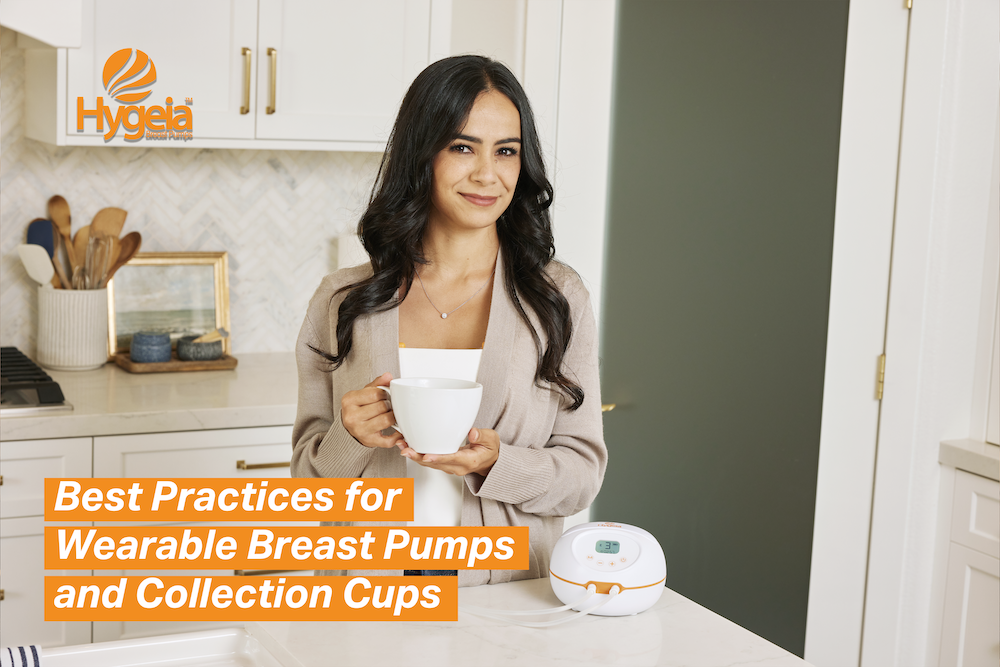
Life with a newborn moves fast and before you know it, a work schedule beckons. Many moms want to continue providing breast milk for their babies past those first weeks of infancy, but traditional pumping can tie them down or be too all-consuming to fit into the schedule. This is where wearable breast pumps and collection cups come in. These innovative tools offer incredible freedom, letting you pump discreetly while you tackle chores, work, or simply enjoy hands-free moments. But to get the most out of them, knowing a few best practices for wearable breast pumps helps.
Understanding Wearable Technology
Wearable breast pumps are small, motor-driven pumps that fit inside your bra. They collect milk directly into a cup, freeing you from bottles and tubes hanging from your chest.
Collection cups, on the other hand, are designed to fit with a traditional pump’s motor, replacing the standard bottles to offer a more discreet, in-bra pumping experience.
Both aim to make pumping on the go easier and more integrated into your daily life.
Choosing the Right Fit: Flange Sizing Matters
Just like with any breast pump, flange size is critical for comfort and efficient milk expression with wearable pumps and collection cups. A flange that’s too small or too large can lead to discomfort, pain, and reduced milk output.
How to Check: After a few minutes of pumping, look at your nipple. It should move freely in the tunnel without too much of the areola being pulled in.
Signs of Poor Fit: Pain, redness, nipple blanching (turning white), or feeling like you’re not fully emptying your breast
Solution: Many brands offer various flange sizes. If you’re unsure, consult a lactation consultant for a proper fitting. Getting this right prevents pain and maximizes your milk production. In some cases moms can do best without inserts in their wearables.
Maximizing Your Wearable Pumping Sessions
Even with the convenience of wearable pumps, technique still matters for a good milk yield. Additionally, using only this hands-free technology for pumping isn’t recommended by many experts.
Reserve Wearable Pumping Time: Use your wearable pump and collection cups only a few times a day if you are exclusively pumping or semi-exclusively pumping. Choose the circumstances or times when it is most helpful, like car rides or when juggling kid demands.
Plan for Longer Pump Sessions: Pump until your breasts feel empty or milk flow significantly slows. This might vary from session to session, but many moms need to pump longer (often 10+ minutes more than usual) to get the same level of stimulation and milk.
Standard Prep and Set Up Matters: Keep to your regular best practices for pumping. A gentle breast massage or warm compress before you start can help with milk let-down. Be sure to have water close at hand and stay hydrated.
Proper Placement: Ensure the collection cup or wearable pump is positioned correctly against your breast, forming a good seal. This prevents leaks and ensures efficient suction.
Cycle and Suction Settings: Experiment with the settings. Start with a faster, lighter suction to encourage let-down, then switch to a slower, deeper suction cycle for milk expression. Adjust suction to a comfortable level. You should never feel pain.
Cleaning and Maintenance for Longevity
Maintaining hygiene is crucial for any breast pump, especially wearable pumps and collection cups that touch your skin and milk directly.
Wash After Each Use: Disassemble all parts that come into contact with milk. Wash them immediately with warm, soapy water and rinse thoroughly.
Sterilize Regularly: Sterilize parts according to manufacturer instructions, usually daily or every few days, especially for newborns.
Air Dry Completely: Allow all parts to air dry completely on a clean paper towel or drying rack to prevent bacterial growth.
Check for Wear and Tear: Regularly inspect silicone parts for rips or cracks, as these can affect suction and hygiene. Replace them as needed.
Embrace the Freedom You Deserve with Hygeia Health
Wearable breast pumps and collection cups are game-changers for active moms, offering flexibility and discreetness. By following these best practices, you can ensure comfortable, efficient milk expression and maintain your milk supply.
At Hygeia Health, we understand the demands of modern motherhood. We are committed to providing high-quality breast pumps that support your unique breastfeeding journey. Did you know that many insurance plans cover the cost of a breast pump? Hygeia Health specializes in helping moms like you navigate this process to get a 100% insurance-covered breast pump.
Ready to experience the freedom of efficient, discreet pumping? Apply here to see if you qualify for a 100% insurance-covered breast pump and make your breastfeeding journey smoother.

